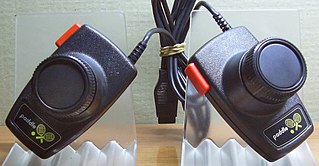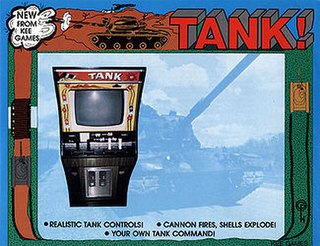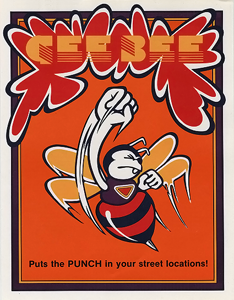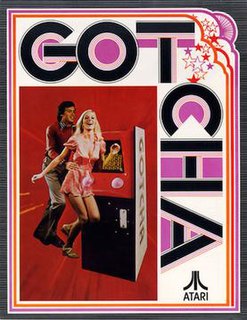
The Atari 2600, originally sold as the Atari Video Computer System or Atari VCS until November 1982, is a home video game console from Atari, Inc. Released on September 11, 1977, it is credited with popularizing the use of microprocessor-based hardware and games contained on ROM cartridges, a format first used with the Fairchild Channel F in 1976. This contrasts with the older model of having dedicated hardware that could play only those games that were physically built into the unit. The 2600 was bundled with two joystick controllers, a conjoined pair of paddle controllers, and a game cartridge: initially Combat, and later Pac-Man.

The Atari 5200 SuperSystem, commonly known as the Atari 5200, is a home video game console that was introduced in 1982 by Atari Inc. as a higher-end complementary console for the popular Atari 2600. The 5200 was created to compete with the Intellivision, but wound up more directly competing with the ColecoVision shortly after its release.

Pong is one of the earliest arcade video games. It is a table tennis sports game featuring simple two-dimensional graphics. The game was originally manufactured by Atari, which released it in 1972. Allan Alcorn created Pong as a training exercise assigned to him by Atari co-founder Nolan Bushnell. Bushnell based the idea on an electronic ping-pong game included in the Magnavox Odyssey; Magnavox later sued Atari for patent infringement. Bushnell and Atari co-founder Ted Dabney were surprised by the quality of Alcorn's work and decided to manufacture the game.

A paddle is a game controller with a round wheel and one or more fire buttons, where the wheel is typically used to control movement of the player object along one axis of the video screen. A paddle controller rotates through a fixed arc ; it has a stop at each end.
The Atari Game Brain is an unreleased dedicated video game console by Atari, intended to be released in June 1978. It plays 10 particular games, ported from all of Atari's previously released dedicated consoles, such as Pong, Stunt Cycle, and Video Pinball. Its controllers were built onto the system, with 4 directional buttons, a paddle, and a fire button. Games are inserted in the top of the system by opening a door that also bears a small instruction booklet.
The Atari Flashback is a series of dedicated consoles marketed by Atari, Inc. from 2004 to 2011. Since 2011, the consoles have been produced and marketed by AtGames under license from Atari. They are "plug and play" versions of the classic Atari 2600 and Atari 7800 consoles; rather than using ROM cartridges, the games are built-in.

Samuel Frederick Dabney Jr. was an American electrical engineer, and the co-founder, alongside Nolan Bushnell, of Atari, Inc. He is recognized as developing the basics of video circuitry principles that were used for Computer Space and later Pong, one of the first and most successful arcade games.
Amiga Corporation was a United States computer company formed in the early 1980s as Hi-Toro. It is most famous for having developed the Amiga computer, code named Lorraine.

Tank is an arcade game developed by Kee Games, a subsidiary of Atari, and released in November 1974. It was the only original title not based on an existing Atari property developed by Kee Games, which was founded to sell clones of Atari games to distributors as a fake competitor prior to the merger of the two companies. In the game, two players drive tanks through a maze viewed from above while attempting to shoot each other and avoid mines, represented by X marks, in a central minefield. Each player controls their tank with a pair of joysticks, moving them forwards and back to drive, reverse, and steer, and firing shells with a button to attempt to destroy the other tank. The destruction of a tank from a mine or shell earns the opposing player a point, and tanks reappear after being destroyed. The winner is the player with more points when time runs out, with each game typically one or two minutes long.

The APF TV Fun home video game consoles are a series of dedicated consoles manufactured by APF Electronics Inc. and built in Japan starting in 1976. The systems were among the first built on the General Instrument 'Pong on a chip', the AY-3-8500, that allowed many manufacturers to compete against the Atari home pong. The APF TV Fun consoles were one of the eraliest pong clone consoles.

Gee Bee is a block breaker/video pinball hybrid arcade game developed and published by Namco in 1978. The player controls a set of paddles with a rotary knob, with the objective being to score as many points as possible by deflecting a ball against bricks, pop bumpers and other objects in the playfield. It was developed by Toru Iwatani, known as the creator of Pac-Man and Pole Position. Outside Japan, it was published by Gremlin Industries.

Video Olympics is a video game programmed by Atari, Inc.'s Joe Decuir for the Atari 2600. It is one of the nine original launch titles for that system when it was released in September 1977. The cartridge is a collection of games from Atari's popular arcade Pong series. A similar collection in arcade machine form called Tournament Table was published by Atari in 1978.

Gotcha is an arcade game developed by Atari and released in October 1973. It was the fourth game by the company, after the 1972 Pong, which marked the beginning of the commercial video game industry, and the 1973 Space Race and Pong Doubles. In the game, two players move through a maze, which continually changes over time. One player, the Pursuer, attempts to catch the other, the Pursued; if they do, a point is scored, and the players reset positions. The game emits an electronic beeping sound, which increases in pace as the Pursuer gets closer to the Pursued, and each game lasts a set amount of time.

Rebound is a two-player sports arcade game developed by Atari, Inc. and released in February 1974. In the game, two players each control paddles on either side of a volleyball net, with a ball dropped from the top of the screen. The players bounce the ball back and forth across the net with the goal of scoring points by having the ball reach the bottom or side of the other player's half of the screen, with the trajectory of the ball dependent on where it strikes the paddle. The winner is the first player to reach eleven or fifteen points, depending on the game settings.

Atari, Inc. was an American video game developer and home computer company founded in 1972 by Nolan Bushnell and Ted Dabney. Primarily responsible for the formation of the video arcade and modern video game industries, the company was closed and its assets split in 1984 as a direct result of the Video game crash of 1983.

Video Pinball is a game for the Atari 2600 programmed by Bob Smith and released by Atari, Inc. in 1980. The Sears rebranded version for its Tele-Games system is Arcade Pinball.

Sierra was the code name for a 16-bit/32-bit personal computer designed by Atari's Sunnyvale Research Lab (SRL) starting around 1983. The design included a new GPU known as "Silver and Gold", a powerful sound synthesizer known as AMY, and a new operating system code-named "Eva". The two-chip GPU was collectively known as Rainbow, and the system is sometimes referred to by this name. The CPU had not been chosen, but the Motorola 68000 and Intel 286 were being considered.
Cyan Engineering was an American computer engineering company located in Grass Valley, California. It was founded by Steve Mayer and Larry Emmons. The company was purchased in 1973 by Atari Inc. and was responsible for development of the Atari VCS console, which was later renamed the Atari 2600. It also carried out some robotics research and development work on behalf of Atari, most notably in the form of the Kermit mobile robot, originally intended as a stand-alone product intended to bring a beer.

The Atari CX40 joystick was the first widely used cross-platform game controller. The original CX10 appeared on the Atari 2600 in 1977, and was considered such a great advance over other controllers that it became the primary input device for most games on the platform. The CX10 was replaced after a year by the much simpler and less expensive CX40. The addition of the Atari joystick port to other platforms cemented its popularity, and millions of CX40s were produced and used on almost every game console and home computer of the era.


















